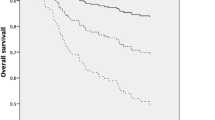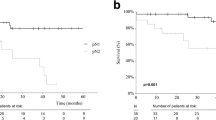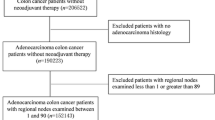Abstract
Purpose
Lymph node size as a prognostic parameter has not been investigated well in the past. Recent data, however, have indicated that this parameter could be even more important than the lymph node count.
Methods
Based on the results of earlier studies, we analyzed the lymph node size and number of node-negative colon cancer patients with regard to survival. Data from 115 node-negative cases of colon cancer were analyzed. Lymph nodes with diameters ≤5 mm were defined as small, and all other lymph nodes were classified as intermediate/large in size and labeled LN5. All of the cases were categorized according to the number of LN5s. The LN5 very low (LN5vl) group included cases with less than two LN5s. All of the other cases were assigned to the LN5 low/high (LN5l/h) group.
Results
The overall survival analysis revealed significantly worse outcomes for the LN5vl group, with a mean survival of 34 months compared to the LN5l/h group, with a mean survival of 40 months (P = 0.022). After adjusting for the pT1/2 and pT3/4 stages, we still found a significant outcome difference (P = 0.012). Multivariate analysis identified LN5vl and T-stage as being independently correlated with the outcome. The vast majority of LN5vl cases (91 %) were located in the left colon. The location itself, however, was not prognostic (P = 0.478).
Conclusion
LN5 count, as a marker of immune response, could be shown as being prognostic in node-negative colon cancer. Patients with low LN5 counts showed poor outcomes. These patients could perhaps profit from adjuvant chemotherapy.


Similar content being viewed by others
References
Ferlay J, Steliarova-Foucher E, Lortet-Tieulent J, Rosso S, Coebergh JW, Comber H, Forman D, Bray F (2013) Cancer incidence and mortality patterns in Europe: estimates for 40 countries in 2012. Eur J Cancer 49(6):1374–1403. doi:10.1016/j.ejca.2012.12.027
Brenner H, Kloor M, Pox CP (2014) Colorectal cancer. Lancet 383(9927):1490–1502. doi:10.1016/S0140-6736(13)61649-9
Lan YT, Chang SC, Yang SH, Lin CC, Wang HS, Jiang JK, Chen WS, Lin TC, Chiou SH, Lin JK (2014) Comparison of clinicopathological characteristics and prognosis between early and late recurrence after curative surgery for colorectal cancer. Am J Surg 207(6):922–930. doi:10.1016/j.amjsurg.2013.08.035
Roxburgh CS, McMillan DC, Richards CH, Atwan M, Anderson JH, Harvey T, Horgan PG, Foulis AK (2014) The clinical utility of the combination of T stage and venous invasion to predict survival in patients undergoing surgery for colorectal cancer. Ann Surg 259(6):1156–1165. doi:10.1097/SLA.0000000000000229
Gill S, Loprinzi CL, Sargent DJ, Thome SD, Alberts SR, Haller DG, Benedetti J, Francini G, Shepherd LE, Francois Seitz J, Labianca R, Chen W, Cha SS, Heldebrant MP, Goldberg RM (2004) Pooled analysis of fluorouracil-based adjuvant therapy for stage II and III colon cancer: who benefits and by how much? J Clin Oncol 22(10):1797–1806
Jepsen RK, Ingeholm P, Lund EL (2012) Upstaging of early colorectal cancers following improved lymph node yield after methylene blue injection. Histopathology 61(5):788–794. doi:10.1111/j.1365-2559.2012.04287.x
Märkl B, Kerwel TG, Jähnig HG, Oruzio D, Arnholdt HM, Schöler C, Anthuber M, Spatz H (2008) Methylene blue-assisted lymph node dissection in colon specimens: a prospective, randomized study. Am J Clin Pathol 130(6):913–919. doi:10.1309/AJCPVAPB5APABJNX
Kerwel TG, Spatz J, Anthuber M, Wunsch K, Arnholdt H, Markl B (2009) Injecting methylene blue into the inferior mesenteric artery assures an adequate lymph node harvest and eliminates pathologist variability in nodal staging for rectal cancer. Dis Colon Rectum 52(5):935–941. doi:10.1007/DCR.0b013e31819f28c9
Tornroos A, Shabo I, Druvefors B, Arbman G, Olsson H (2011) Postoperative intra-arterial methylene blue injection of colorectal cancer specimens increases the number of lymph nodes recovered. Histopathology 58(3):408–413. doi:10.1111/j.1365-2559.2011.03755.x
Iachetta F, Reggiani Bonetti L, Marcheselli L, Di Gregorio C, Cirilli C, Messinese S, Cervo GL, Postiglione R, Di Emidio K, Pedroni M, Longinotti E, Federico M, Ponz de Leon M (2013) Lymph node evaluation in stage IIA colorectal cancer and its impact on patient prognosis: a population-based study. Acta Oncol 52(8):1682–1690. doi:10.3109/0284186x.2013.808376
Chang GJ, Rodriguez-Bigas MA, Skibber JM, Moyer VA (2007) Lymph node evaluation and survival after curative resection of colon cancer: systematic review. J Natl Cancer Inst 99(6):433–441. doi:10.1093/jnci/djk092
Chen HH, Chakravarty KD, Wang JY, Changchien CR, Tang R (2010) Pathological examination of 12 regional lymph nodes and long-term survival in stages I-III colon cancer patients: an analysis of 2,056 consecutive patients in two branches of same institution. Int J Color Dis 25(11):1333–1341. doi:10.1007/s00384-010-1020-8
Norwood MG, Sutton AJ, West K, Sharpe DP, Hemingway D, Kelly MJ (2010) Lymph node retrieval in colorectal cancer resection specimens: national standards are achievable, and low numbers are associated with reduced survival. Color Dis 12(4):304–309. doi:10.1111/j.1463-1318.2009.01788.x
Märkl B, Rössle J, Arnholdt HM, Schaller T, Krammer I, Cacchi C, Jähnig H, Schenkirsch G, Spatz H, Anthuber M (2012) The clinical significance of lymph node size in colon cancer. Mod Pathol 25(10):1413–1422. doi:10.1038/modpathol.2012.92
Kim YW, Jan KM, Jung DH, Cho MY, Kim NK (2013) Histological inflammatory cell infiltration is associated with the number of lymph nodes retrieved in colorectal cancer. Anticancer Res 33(11):5143–5150
Märkl B, Schaller T, Kokot Y, Endhardt K, Kretsinger H, Hirschbühl K, Aumann G, Schenkirsch G (2015) Lymph node size as a simple prognostic factor in node negative colon cancer and an alternative thesis to stage migration. Am J Surg. doi:10.1016/j.amjsurg.2015.05.026
Märkl B, Kerwel TG, Jahnig HG, Oruzio D, Arnholdt HM, Scholer C, Anthuber M, Spatz H (2008) Methylene blue-assisted lymph node dissection in colon specimens: a prospective, randomized study. Am J Clin Pathol 130(6):913–919. doi:10.1309/AJCPVAPB5APABJNX
Schemper M, Smith TL (1996) A note on quantifying follow-up in studies of failure time. Control Clin Trials 17(4):343–346
Lykke J, Roikjaer O, Jess P, Danish Colorectal Cancer G (2013) The relation between lymph node status and survival in stage I-III colon cancer: results from a prospective nationwide cohort study. Color Dis 15(5):559–565. doi:10.1111/codi.12059
Prandi M, Lionetto R, Bini A, Francioni G, Accarpio G, Anfossi A, Ballario E, Becchi G, Bonilauri S, Carobbi A, Cavaliere P, Garcea D, Giuliani L, Morziani E, Mosca F, Mussa A, Pasqualini M, Poddie D, Tonetti F, Zardo L, Rosso R (2002) Prognostic evaluation of stage B colon cancer patients is improved by an adequate lymphadenectomy: results of a secondary analysis of a large scale adjuvant trial. Ann Surg 235(4):458–463
Willaert W, Mareel M, Van De Putte D, Van Nieuwenhove Y, Pattyn P, Ceelen W (2014) Lymphatic spread, nodal count and the extent of lymphadenectomy in cancer of the colon. Cancer Treat Rev 40(3):405–413. doi:10.1016/j.ctrv.2013.09.013
Feinstein AR, Sosin DM, Wells CK (1985) The Will Rogers phenomenon. Stage migration and new diagnostic techniques as a source of misleading statistics for survival in cancer. N Engl J Med 312(25):1604–1608. doi:10.1056/NEJM198506203122504
Märkl B, Schaller T, Krammer I, Cacchi C, Arnholdt HM, Schenkirsch G, Kretsinger H, Anthuber M, Spatz H (2013) Methylene blue-assisted lymph node dissection technique is not associated with an increased detection of lymph node metastases in colorectal cancer. 26 (9):1246-1254. doi:10.1038/modpathol.2013.61
O’Shea A, Aly O, Parnaby CN, Loudon MA, Samuel LM, Murray GI (2014) Increased lymph node yield in colorectal cancer is not necessarily associated with a greater number of lymph node positive cancers. PLoS ONE 9(8), e104991. doi:10.1371/journal.pone.0104991
Zhang BB, Chen TT, Wei QZ, Wang GC, Lu M (2013) Risk factors for survival after colorectal cancer resection. Hepatogastroenterology 60(123):528–532. doi:10.5754/hge12759
Mathis KL, Green EM, Sargent DJ, Delaney C, Simmang CL, Nelson H (2013) Surgical quality surrogates do not predict colon cancer survival in the setting of technical credentialing: a report from the prospective COST trial. Ann Surg 257(1):102–107. doi:10.1097/SLA.0b013e318260a8e6
Sloothaak DA, Grewal S, Doornewaard H, van Duijvendijk P, Tanis PJ, Bemelman WA, van der Zaag ES, Buskens CJ (2014) Lymph node size as a predictor of lymphatic staging in colonic cancer. Br J Surg 101(6):701–706. doi:10.1002/bjs.9451
Dworak O (1991) Morphology of lymph nodes in the resected rectum of patients with rectal carcinoma. Pathol Res Pract 187(8):1020–1024
Nacopoulou L, Azaris P, Papacharalampous N, Davaris P (1981) Prognostic significance of histologic host response in cancer of the large bowel. Cancer 47(5):930–936
Patt DJ, Brynes RK, Vardiman JW, Coppleson LW (1975) Mesocolic lymph node histology is an important prognostic indicator for patients with carcinoma of the sigmoid colon: an immunomorphologic study. Cancer 35(5):1388–1396
Pihl E, Nairn RC, Milne BJ, Cuthbertson AM, Hughes ES, Rollo A (1980) Lymphoid hyperplasia: a major prognostic feature in 519 cases of colorectal carcinoma. Am J Pathol 100(2):469–480
Okada K, Sadahiro S, Suzuki T, Tanaka A, Saito G, Masuda S, Haruki Y (2015) The size of retrieved lymph nodes correlates with the number of retrieved lymph nodes and is an independent prognostic factor in patients with stage II colon cancer. Int J Color Dis 30(12):1685–1693. doi:10.1007/s00384-015-2357-9
van Erning FN, Crolla RM, Rutten HJ, Beerepoot LV, van Krieken JH, Lemmens VE (2014) No change in lymph node positivity rate despite increased lymph node yield and improved survival in colon cancer. Eur J Cancer 50(18):3221–3229. doi:10.1016/j.ejca.2014.10.011
Hanahan D, Weinberg RA (2011) Hallmarks of cancer: the next generation. Cell 144:646–674
Morimoto M, Miyakura Y, Lefor AT, Takahashi K, Horie H, Koinuma K, Tanaka H, Ito H, Shimizu T, Kono Y, Sata N, Fukushima N, Sakatani T, Yasuda Y (2014) Reduction in the size of enlarged pelvic lymph nodes after chemoradiation therapy is associated with fewer lymph node metastases in locally advanced rectal carcinoma. Surg Today. doi:10.1007/s00595-014-1007-0
Figueredo A, Coombes ME, Mukherjee S (2008) Adjuvant therapy for completely resected stage II colon cancer. Cochrane Database Syst Rev 3, CD005390. doi:10.1002/14651858.CD005390.pub2
Märkl B, Schaller T, Märkl M Prognostic stratification of nodal negative colon cancer by a new morphology based risk score. In: Laboratory investigation, 2015. Nature Publishing Group 75 Varick st, 9th Flr, New York, NY 10013-1917 USA, pp 178A-178A
Acknowledgments
The authors are grateful to Kai-Uwe Hebick for careful data management.
Author contributions
Patrick Mayr: study conception and design, acquisition of data, analysis and interpretation of data, and drafting of manuscript.
Georg Aumann: analysis and interpretation of data and critical revision of manuscript.
Tina Schaller: acquisition of data and critical revision of manuscript.
Gerhard Schenkirsch: acquisition of data and critical revision of manuscript.
Matthias Anthuber: study conception and design and critical revision of manuscript.
Bruno Märkl: study conception and design, acquisition of data, analysis and interpretation of data, and critical revision of manuscript.
Author information
Authors and Affiliations
Corresponding author
Ethics declarations
Conflicts of interest
Patrick Mayr declares that he has no conflicts of interest.
Georg Aumann declares that he has no conflicts of interest.
Tina Schaller declares that she has no conflicts of interest.
Gerhard Schenkirsch declares that he has no conflicts of interest.
Matthias Anthuber declares that he has no conflicts of interest.
Bruno Märkl declares that he has no conflicts of interest
Ethical approval
This article does not contain any studies with human participants or animals performed by any of the authors.
Rights and permissions
About this article
Cite this article
Mayr, P., Aumann, G., Schaller, T. et al. Lymph node hypoplasia is associated with adverse outcomes in node-negative colon cancer using advanced lymph node dissection methods. Langenbecks Arch Surg 401, 181–188 (2016). https://doi.org/10.1007/s00423-016-1377-4
Received:
Accepted:
Published:
Issue Date:
DOI: https://doi.org/10.1007/s00423-016-1377-4




